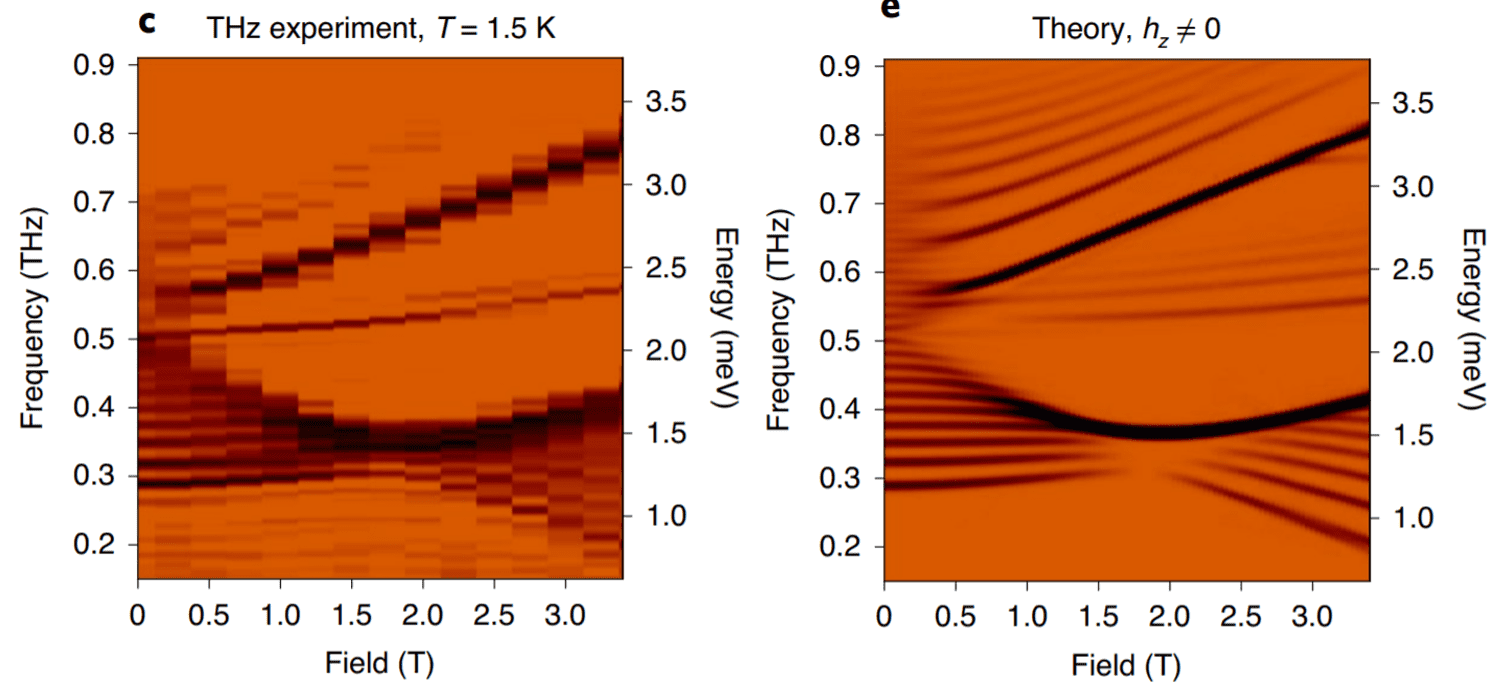
Duality and domain wall dynamics in a twisted Kitaev chain
By combining synthesis, THz spectroscopy, and theory, we show CoNb2O6 is a “twisted Kitaev chain” with bond dependent anisotropic interactions similar to those of the honeycomb Kitaev spin liquid.
Find Out More Duality and domain wall dynamics in a twisted Kitaev chain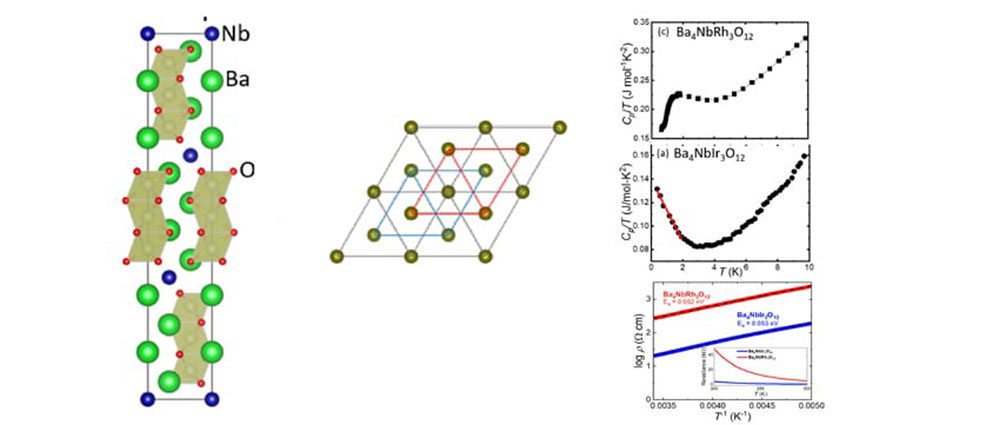
New trimer-based spin liquid candidates
A previously unreported family of materials has been discovered with unconventional magnetic properties that are consistent the realization of the quantum spin liquid. The materials consist of triangular lattices of magnetic trimer molecules of the form Rh3O12 and Ir3O12 with 4d and 5d electron based magnetism.
Find Out More New trimer-based spin liquid candidates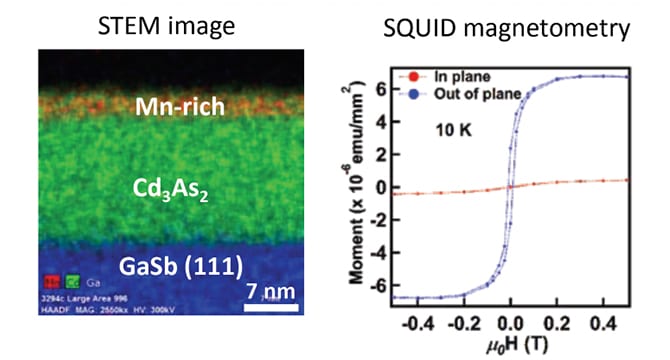
Interfacing a Dirac semimetal with magnetism
We have measured Fermi-energy-dependent quantum transport in electrostatically-gated thin films of the Dirac semimetal Cd3As2 interfaced with a ferromagnet.
Find Out More Interfacing a Dirac semimetal with magnetism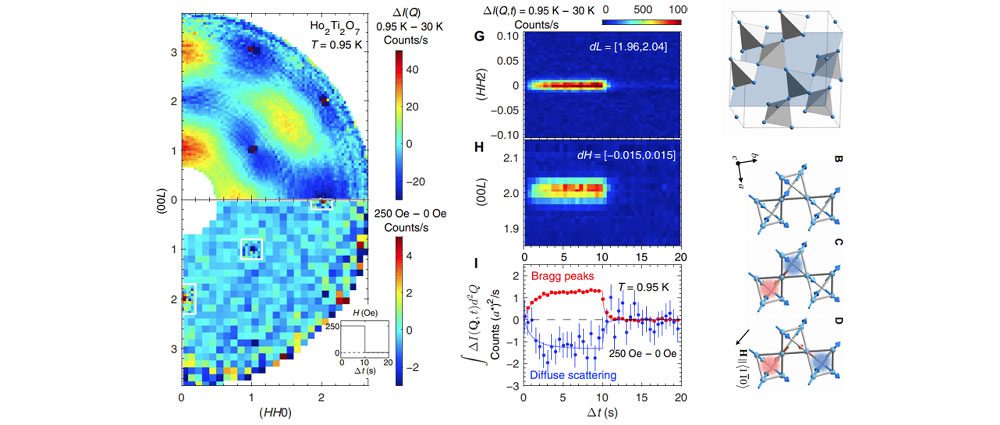
Monopolar and dipolar relaxation in spin ice Ho2Ti2O7
Using a novel time-resolved neutron scattering technique and a new class of ultra-pure crystals, two distinct magnetic relaxation processes were discovered in the spin-ice compound Ho2Ti2O7. The cross-over in the relaxation dynamics is associated with spin fractionalization into monopoles.
Find Out More Monopolar and dipolar relaxation in spin ice Ho2Ti2O7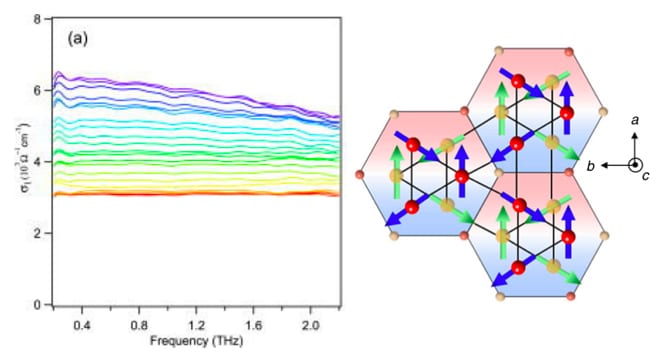
Room-temperature THz anomalous Hall effect in Weyl antiferromagnet Mn3Sn films
Using time-domain THz spectroscopy and polarimetry, we have measured the magneto-optical response of the Weyl AF Mn3Sn. A large anomalous Hall conductivity |σxy|~20 Ω- 1cm-1 at THz frequencies is clearly observed as polarization rotation. Gapping of the Fermi surfaces is apparent due to translation symmetry breaking in the helical phase.
Find Out More Room-temperature THz anomalous Hall effect in Weyl antiferromagnet Mn3Sn films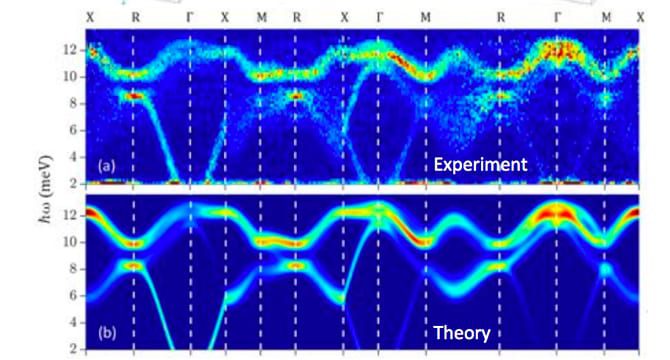
Magnons from molecular spins in chiral Cu20Se03
The asymmetric magnetic interactions that control the low energy excitations and the skyrmionic spin texture of Cu2OSeO3 were determined using inelastic neutron scattering and a coarse-grained description of this chiral breathing pyrochlore ferrimagnet.
Find Out More Magnons from molecular spins in chiral Cu20Se03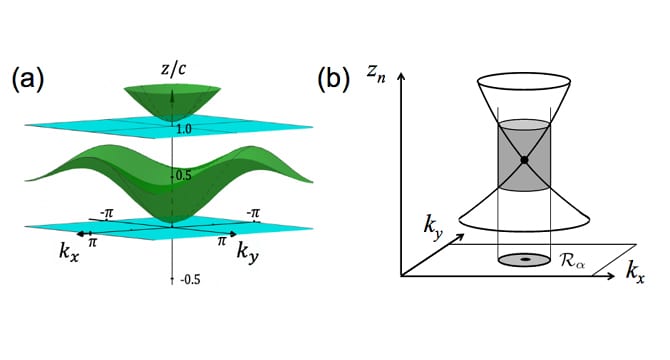
Axion Magnetoelectric Coupling in the Hybrid Wannier Representation
A large class of topological insulators (TIs) is characterized by the presence of a quantized magneto-electric (ME) “axion” coupling. We have developed a detailed theory connecting this axion coupling to features of the hybrid Wannier (HW) representation, which has emerged as one of the most important theoretical tools for understanding TIs.
Find Out More Axion Magnetoelectric Coupling in the Hybrid Wannier Representation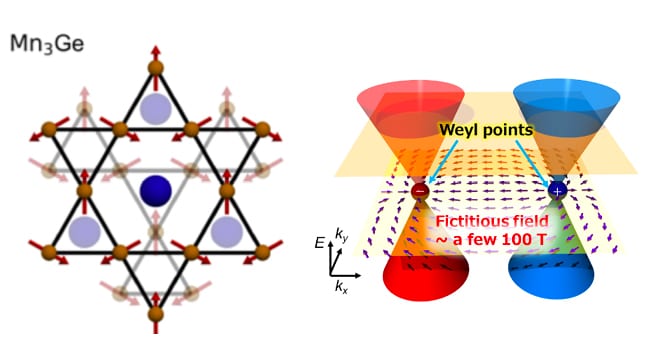
Anti-chiral spin order its Goldstone modes and their hybridization with phonons in the topological semimetal Mn3Ge
The anti-chiral spin structure of Mn3Ge and its low energy excitations were determined using neutron scattering techniques. We developed a field theory of long-wavelength spin waves for Mn3Ge and establish a spin-Hamiltonian model, which accounts for the spin order and low energy excitations.
Find Out More Anti-chiral spin order its Goldstone modes and their hybridization with phonons in the topological semimetal Mn3Ge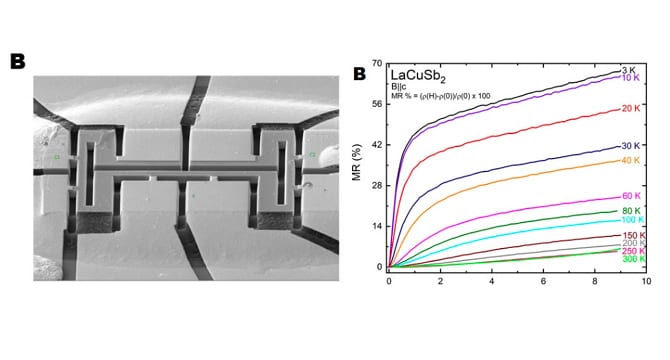
Dirac Fermions and Possible Weak Antilocalizationin LaCuSb2
We predicted and then experimentally showed that LaCuSb2, previously reported to be superconducting, hosts Dirac fermions with an effective mass of 0.06 me.
Find Out More Dirac Fermions and Possible Weak Antilocalizationin LaCuSb2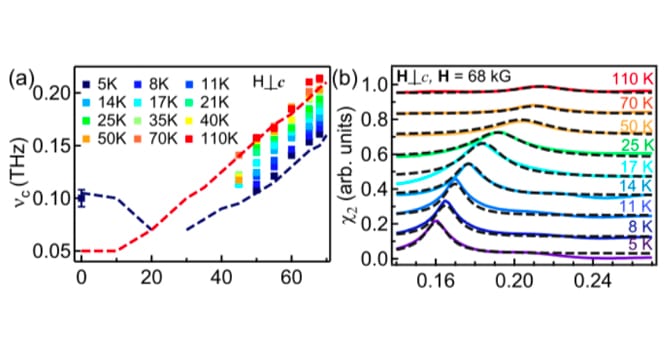
Probing magnon dynamics and interactions in a ferromagnetic spin-1 chain
Using time-domain THz spectroscopy, we measure the low-energy EM response of the spin-1 ferromagnetic spin chain NiNb2O6 as a function of temperature and external magnetic field.
Find Out More Probing magnon dynamics and interactions in a ferromagnetic spin-1 chain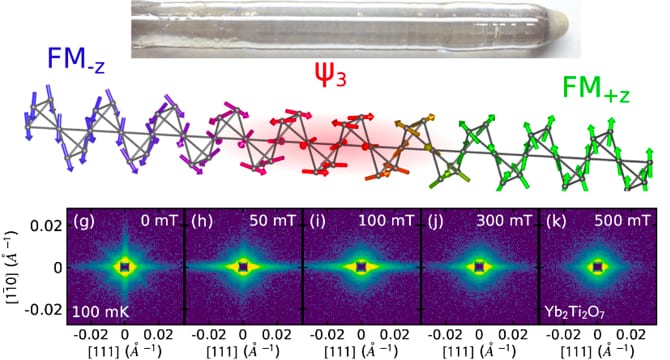
Antiferromagnetic domain walls in ferromagnetic Yb2Ti2O7
We show that ferromagnetic and antiferromagnetic states are nearly degenerate in the frustrated quantum magnet Yb2Ti2O7. The long range nature of dipole interactions consequently induce a mixed FM/AFM state at low fields where AFM slabs serve as domain walls.
Find Out More Antiferromagnetic domain walls in ferromagnetic Yb2Ti2O7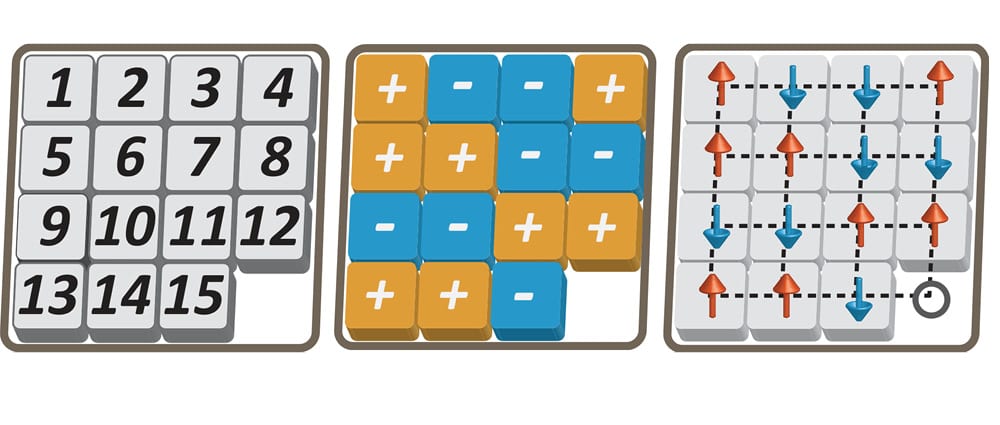
Puzzling Itinerant Magnetism
Yi Li and two graduate students, Eric Bobrow and Keaton Stubis, studied itinerant ferro magnetism arising from the coherent motion of a single hole in the strong interaction regime. Using the mathematics of the 15-puzzle, they extended a well-known theorem that describes this itinerant ferromagnetism to almost every non-separable graph.
Find Out More Puzzling Itinerant Magnetism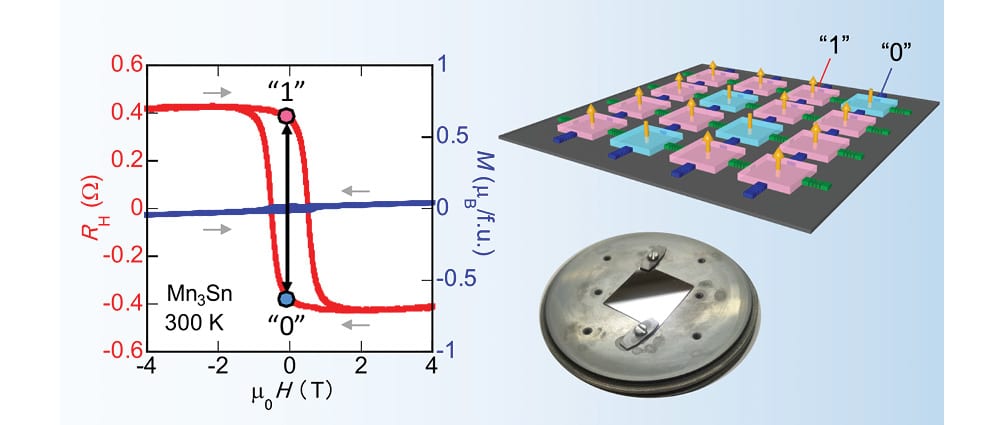
Topological Magnetic Metal for Spintronics
A team led by Satoru Nakatsuji discovered large anomalous Hall, anomalous Nernst, and magneto-optical Kerr effects at room temperature in the antiferromagnetic metal Mn3Sn – a first example of a magnetic Weyl metal. In collaboration with Chia-Ling Chien’s group at JHU, they also succeeded in making high-quality Mn3Sn thin films through sputtering.
Find Out More Topological Magnetic Metal for SpintronicsThe Institute for Quantum Matter is an Energy Frontier Research Center that is realizing revolutionary quantum materials and structures where quantum effects such as entanglement and coherence find collective macroscopic manifestations. We expose, understand, and control the corresponding physical properties and explore their potential for energy-related applications.
